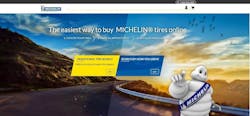More than three years after launching its e-commerce platform in the U.S., Michelin North America Inc. is shutting it down. The tiremaker is suspending all direct-to-consumer passenger and light truck tire sales on April 30. Michelin was the second major tire manufacturer to create an online platform to sell tires to consumers. Goodyear Tire & Rubber Co. was the first, launching in 2015. Michelin entered the fray in September 2016 with its BFGoodrich brand, and in December of that year began selling tires online at www.MichelinMan.com. The company also has sold its Uniroyal tires online to consumers.
Yahn Heurlin is director of marketing for Michelin’s business-to-consumer business. He detailed the reasons behind the decision during an exclusive interview with Modern Tire Dealer.
Heurlin says it goes back to the company’s three-pronged e-business strategy:
- E-commerce
- Lead generation, conversion and nurturing
- Developing shared business plans with other leading e-retailers
“We have worked consistently to deliver against those three leading initiatives,” Heurlin says. “And when we started the e-commerce initiative specifically we said from day one that our objective was not to become an e-retailer ourselves.”
He says Michelin wanted to study and develop expertise in the consumer’s journey as they shopped for and bought tires online, including how the online path resulted in a customer’s visit to a brick and mortar store. The goal was to “become the experts in the industry … the category captains.”
Now, the tiremaker will turn its focus to the next two points in the strategy on that original list, Heurlin says.
Notably, the end of the e-commerce platforms in the U.S. at www.MichelinMan.com and www.BFGoodrichTires.com, closes the company’s direct-to-consumer strategy globally — at least when it comes to passenger and light truck tires.
A Tweel exception
Heurlin says the company will continue to sell some specialty tires direct to those customers online, notably the Tweel. “That e-shop will remain, and we certainly do not exclude the idea of adding other e-shops where the challenge is a bit different for those specific activities. It’s all about granting easy and large access to those specialized offers.”
So why keep an online channel for the Tweel?
“It’s a more complex story to articulate,” Heurlin says. “We want to make sure that customers can get all the relevant information that they need to make their purchase decision. It’s primarily a question of giving as broad access as possible to as many customers as possible for that product.
“We are developing our distribution access in the physical world but we think as we are ramping up and developing significantly the sales of that product we still need an e-shop to accelerate the sales.”
Dealers were ‘quite happy with the program’ When tiremakers moved into the online sales space, they were met with great resistance and even fury from their independent tire dealers, and Michelin was not immune to that. Heurlin says Michelin informed dealers of its plans to move out of the direct-to-consumer PLT business a week before the site was to go dark.
Heurlin didn’t wade into that controversy, but called Michelin’s program with dealers for installation “the most interesting program in the market.” He said Michelin gave back “nearly all the installment fee. Dealers also earned a percentage of the price of the tire.
“There were many opportunities for a retailer to increase their margins on those direct sales from Michelin,” Heurlin says.
In 2019 the company enhanced its system as some dealers shared visibility into their inventories, which allowed Michelin to offer same-day installment with those partners. The idea for that functionality came from tire dealers, Heurlin says.
“Our partners were quite happy with the program to be frank.”
He says dealer feedback didn’t prompt Michelin to shut down the online platform.
“The decision to shut down was not a consequence from any reaction of our customers. It’s clearly an illustration of our initial strategy. We are not here to sell tires online. We are here to learn about those shopping journeys. We have learned a lot and we want to leverage those insights and concentrate on the other two pillars that I described.
“We want to accelerate data-driven marketing initiatives around lead generation, conversion and nurturing. And we want to accelerate the development of those shared e-business plans with our different customers. There is a major opportunity in those two dimensions.”
The next frontier
Combined, the three websites for Michelin’s brands generated 14 million visitors. Heurlin says the Michelin site has grown to approximately 8 million unique visitors a year, while the BFGoodrich site has approximately 4 million and the Uniroyal site, which has been evolving with a redesign and new products, has about 2 million unique visitors.
“Those traffic numbers have significantly increased over the last five years. It’s not just thanks to e-commerce. It’s been a journey and any time we learned something we changed it. We added new functionalities and developed a more seamless experience between shopping the site and connecting with our partners’ websites.”
That traffic has given Michelin a trove of data. Heurlin says when it comes to tire lines, sizes and geographies, the products that people shopped and bought didn’t stray from dealers sell in their physical storefronts. There were two differences:
- The overall age of people visiting the websites. Online sales brought with it “significant improvement on people 35 years and below,” Heurlin says.
- There was a slightly richer mix of wheel sizes online.
As it turns to its next steps, Heurlin says it will include partnerships with the online-only sellers like Simple Tire LLC and Tire Rack, as well as dealers who have brick-and-mortar stores plus online storefronts. There are also mass merchandisers who have online platforms, such as Walmart and Amazon. There are different partnerships based on the different needs and dynamics in those segments of the market.
He provided an example of how Michelin could use its data while partnering with another player in the online space.
“Tire Rack has a strong influence when it comes to the winter market in the U.S. Do we want to do something specifically with that winter market opportunity. Do we want to help consumers better understand what is important, what’s critical to choosing a winter tire? And can we design together interesting offers or CRM journeys for those consumers? That’s the kind of thing we want to focus on together.”



